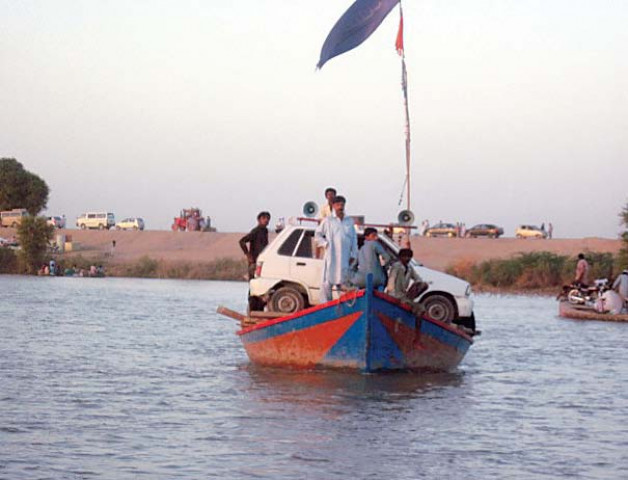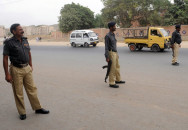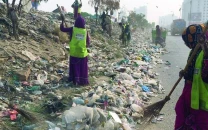Strong prayers for safe arrivals on Dadu’s flimsy boats
Down-and-out farmers earn up to Rs6,000 as boatmen.

Even though the river water’s pressure has declined sharply, the land routes in Johi are still submerged. So the easiest means of getting across the new water channels to Dadu city are the flimsy painted boats with their makeshift oars.
“The water is about ten feet deep. We always start reciting verses from the Quran while travelling in the boat because many of them have overturned,” said a woman, Bajhi Lund, while talking to The Express Tribune.
Apart from being risky, the boat rides also take a very long time. The drain, which starts from zero point in Mehar taluka and flows into the Manchar Lake, has devastated the Johi taluka. Not the drain itself, but the breaches. “I came here to visit our doctor in Dadu,” says Zameer Rind, who was getting off at the Chandan stop and had travelled to take his mother, suffering from a respiratory disease, for a check-up.
A few people, especially those travelling to see doctors, lose their consciousness on the boat. “My son has been suffering from diarrhoea,” says one man, whose son was unconscious a while ago. It is extremely hot and humid.
Nevertheless, the boat ride is light on the pocket - only Rs50 for a one-way trip. Another up-side is how boat travel has provided a newer and more lucrative source of income. “I board around 15 to 20 people in one trip,” says Zameer Mallah, a fisherman turned boatman.
“I can manage around ten trips in a day and easily earn Rs5,000 to Rs6,000 daily,” says another boatman, Nazir Muhammad. According to him, around 50 boats are being transported from only one station. “We had no stable livelihood for the last twenty years, but now I can earn around Rs120,000 a month,” he says, smiling. But the reason why the land routes are submerged in the first place is nothing to smile about. Almost none of the breaches on the left of MNVD have been plugged, despite government claims.
Out of the 10 union councils in Johi, eight are still submerged. The town, with 60,000 people, has been saved by its own people. “Sixty per cent of the people left the day of the first warning [September 3] and the remaining 40 per cent saved the city by making a 14-kilometre ring bund around it,” explains Ghulam Abbas Khoso, the Dadu district manger, Thardeep Rural Development Programme. He says that devastation could have been limited if 32 breaches in the MNVD were plugged.
“Around 2,000 people worked 20 hours or more and filled the bund with 4,000 to 5,000 bags of mud and gravel to make the protective bund.”
On the way to the town, there is a line of little colourful flags made of sticks and colourful scraps of cloth to help the villagers navigate the submerged road. During the two-hour boat ride, all you can see is water. No roads, no standing crops, no villages. Not exactly a romantic Gondola ride.
Published in The Express Tribune, October 25th, 2010.



















COMMENTS
Comments are moderated and generally will be posted if they are on-topic and not abusive.
For more information, please see our Comments FAQ